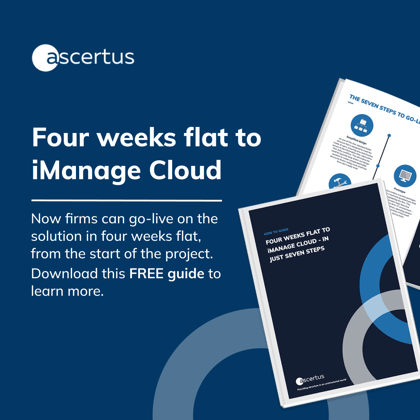
Whilst promising benefits such as cost savings, unprecedented efficiency and productivity gains, technology is inherently disruptive in nature – of course some being more disruptive than others. The generative AI tool, Harvey, is the latest example of such technology in the legal industry. Likewise, if we look at technology that is more established today – i.e., cloud computing – when it first came to the fore, it too was viewed as disruptive to business.
Cloud computing ; a business or technology based decision?
Despite this widely held viewpoint of technologies’ disruptive nature, I often observe that law firms’ adoption of new technologies is almost always a “technology” decision as opposed to a “business” decision. So, whilst technology is seen as disruptive, the question is it also being used to constructively disrupt and transform the approach to business to realise innovation? As firms evaluate and adopt the latest and greatest technology, are they also genuinely exploring how they can change the way they operate?; devise a new business model?; or transform their approach to client experience?
Let’s look at cloud computing. The majority of firms either have or are now moving to the cloud – even the previous nay sayers and sceptics. And rightly so, cloud computing is the way forward. But once firms are on the cloud, firms can’t stand still or be complacent. It is only the first step. Firms need to be looking at how they can use their cloud computing platform – from a business perspective – to make commercial gains, by disrupting their own status quo and potentially that of the arena they operate within.
There are many areas that firms must explore to evolve their approach to business, post their adoption of cloud computing. Immediately, cost management feels like a good place to start – given these times of economic uncertainty in a slightly tumultuous global landscape.
Managing cloud computing cost to deliver value
Foremost, a mindset change is needed. As the technology of cloud computing matures, so must the thinking. Today, cloud computing isn’t about cost savings, rather it’s about its promise of the value the technology will deliver to the business. The discussion around cost then becomes one of “cost management and optimisation”.
Moving away from calculating “how many servers do we have”, firms should be horizon scanning – how much computing power do we need today?; at what rate do we need to scale over the next five years?; in which regions in the world do we need to operate in?; will our data in the cloud meet the data protection requirements of our clients?; are the data centres of our cloud partners located in the right jurisdictions?; are all our business-critical applications in the cloud?; and so forth.
This kind of introspection will facilitate application rationalisation. It’s a great opportunity to review if the application estate can be reduced with newer and fewer cloud native tools that offer more advanced and comprehensive functionality. Likewise, licence optimisation can help significantly reduce unnecessary software costs. As opposed to buying licences for all users as may have been the case with on-premises applications, in the cloud it’s possible to know exactly how many users are actually utilising applications to accurately determine the number of licences that must be purchased.
Join our monthly In The Know newsletter to stay up to date with the latest news and blogs posts
Cloud technologies can redefine business processes
 A major benefit of the cloud is that it’s possible to create a uniform environment for work and business operation. Determining plans and associated costs of integrating multiple applications to create a seamless cloud-based environment for business operation should be a natural next step for firms. This also presents a good opportunity to redefine business processes and even create new workflows to develop innovative ways of working that will directly facilitate enhanced client experience and retention and ultimately the bottom line.
A major benefit of the cloud is that it’s possible to create a uniform environment for work and business operation. Determining plans and associated costs of integrating multiple applications to create a seamless cloud-based environment for business operation should be a natural next step for firms. This also presents a good opportunity to redefine business processes and even create new workflows to develop innovative ways of working that will directly facilitate enhanced client experience and retention and ultimately the bottom line.
For such projects, resource management becomes critical. With cloud technology, the skill set required internally changes because traditional IT department activity such as management of back-end systems, patch updates, software upgrades, and so on are no longer needed. In this scenario, issues like what skill sets do we have internally?; how can they be best redeployed?; is it more cost-effective and efficient to outsource application support and helpdesk activity to external support partners?; are we optimally leveraging the contractual obligations of our third-party suppliers?; and what new skill sets do we need?. This is by no means an exhaustive list, but you get the drift.
Undertaking cost management with an attitude that helps to adopt a transformative approach to business enables firms to draw the most value from cloud computing technology.
Cloud applications provide employee engagement
Also, today, employees across the board – and regardless of the size and type of organisation – expect a certain standard of applications and toolsets in their place of work. Research shows that poor technology makes one in 10 staff want to leave their job. So, whilst the cost of talent retention isn’t a direct component of cost of technology, it’s worth bearing in mind. It is well acknowledged that typically, recruiting an employee costs 20-30% of the individual’s final salary – and this is not taking into account the loss of productivity and impact on the business when the organisation is under-staffed.
Finally, and especially something that smaller and growing organisations should be mindful of when investing in cloud computing – this technology levels the playing field for them. They can have the exact same quality of applications that their bigger and more well-established contemporaries deploy. Advanced technology – alongside the agility and nimbleness that growing organisations typically display – can genuinely give them a competitive advantage.
Other blogs on Cloud Computing include:
- Cloud security - pay attention to your data
- Cloud storage cost
- Cloud migration - are you ready to move iManage Work to the cloud?
- Multi cloud denotes freedom of choice, how should you devise your firm’s cloud strategy?
- Cloud benefits - four critical considerations
- Case Study - Thirsk Winton migrate from private cloud to iManage cloud
FAQ
What is cloud computing and how is it useful?
Cloud computing refers to the practice of using remote servers hosted on the internet to store, manage, and process data rather than using a local server or personal computer. It is useful because it provides flexibility, scalability, and cost-effectiveness. Users can access their data and applications from anywhere with an internet connection, making it convenient for remote work or collaboration. The cloud also allows businesses to easily scale their resources up or down as needed, avoiding the need for expensive infrastructure investments. Additionally, cloud computing offers data backup and disaster recovery solutions, enhancing data security and business continuity.
What is an example of cloud computing?
Amazon Web Services (AWS) is a popular and widely used example of cloud computing. It offers a comprehensive suite of cloud services, including storage, computing power, analytics, and machine learning. With AWS, individuals and businesses can leverage the cloud to host websites, store and analyze large amounts of data, run applications, and deploy virtual servers
What is the cloud?
In simple terms, the cloud refers to using the internet to access and store data, applications, and services on remote servers rather than on your personal computer or local server. It allows you to access and manage your files, email, and other resources from anywhere with an internet connection. The cloud eliminates the need for physical storage devices and provides flexibility and scalability for storing, processing, and sharing data.
This blog is the first article in this series on cloud computing. In the next piece, I’ll discuss considerations to take security to the next level in a cloud environment.
Join our monthly In The Know newsletter to stay up to date with the latest news and blogs posts
Have an iManage cloud question? Contact us...
.png?width=180&height=65&name=Ascertus%20Logo_360x130%20(1).png)